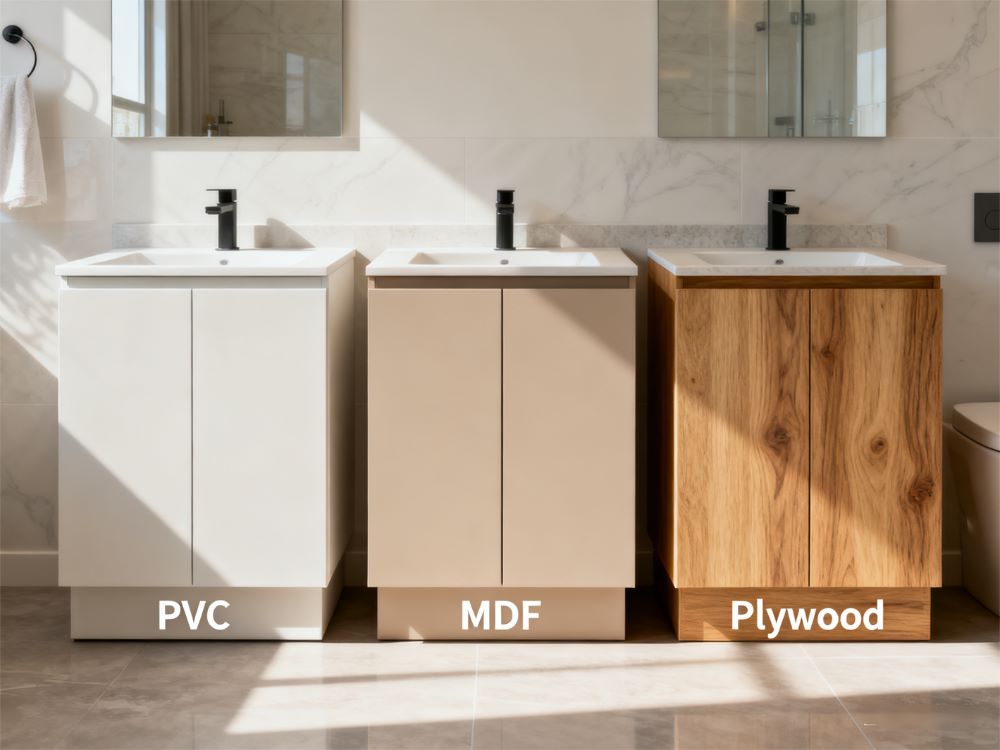When it comes to bathroom cabinets, many homeowners and designers are increasingly turn to other materials, seeking for durability, versatility. And the choice between PVC, MDF, and plywood can feel like a balancing act between durability and style. PVC is the waterproof warrior, built to handle humidity without warping. MDF wins points for smooth finishes and flexibility in design, but it needs protection from moisture. And Plywood? It’s the classic all-rounder — sturdy, natural, and dependable, though it usually comes with a higher price tag. So which material will truly meet your needs while standing the test of time? The article will compare these materials in the context of bathroom cabinets, helping you determine which one is best suited for your next project.

PVC is a lightweight materials made by Polyvinyl Chloride. As crafted from high-grade PVC board, PVC bathroom cabinet 100% waterproof nature makes it ideal for humid environments, ensuring your cabinetry remains intact over time.
It features a durable PVC outer layer and a foam core, combining strength with lightweight at the same time. Unlike MDF, which requires careful sealing to withstand moisture, PVC is low maintenance and doesn't attract pests.
Our MIRPLUS upcoming new series of PVC bathroom cabinets are crafted entirely from high-quality PVC panels, ensuring 100% waterproof and moisture-resistant performance. Different colors, finishes, and shapes mean you can match almost any décor without worrying about upkeep.
Medium-density fiberboard (MDF) is an engineered wood product primarily made from wood fibers, wax, and resin through a process of compression and heat treatment. Its smooth, flat surface makes it highly suitable for painting and veneering, leading to its widespread use in cabinet manufacturing, like kitchen, bathroom.
MDF bathroom cabinets combine affordability with aesthetic charm, making them a favored option for homeowners.
If you prioritize a stylish look on a budget, MDF may suit you, but for long-lasting durability, plywood could be the superior choice.

Plywood bathroom cabinets stand out for their remarkable strength and versatility, making them an excellent choice for those seeking both functionality and aesthetic appeal.
Unlike MDF, which can falter in moisture, plywood maintains structural integrity even in humid environments. You’ll appreciate its natural resistance to warping and deterioration, ensuring longevity in your bathroom. Plus, the aesthetic options are extensive; you can stain or paint plywood to match your unique style.

When it comes to choosing the right material for bathroom cabinets, each material has its unique advantages and weaknesses. Here, let's take a closer look at how these materials compare in various key areas:
While selecting bathroom cabinets, durability plays an essential role in ensuring your investment withstands the test of time and moisture.
Here's what to evaluate:
When deciding between PVC vs MDF vanity or particle board vs MDF for cabinets, you’ll want to weigh your options carefully. PVC cabinets excel in moisture resistance, while plywood offers unmatched durability.
Choosing bathroom cabinets involves not just style and durability, but also cost-effectiveness, which can greatly impact your budget.
In terms of initial cost, PVC is typically the most budget-friendly option, especially for high-moisture areas. MDF offers a stylish mid-range alternative if properly sealed, making it a good choice for dry bathrooms. Compare to these two types, plywood is more expensive for the same specification.
But for long-term value, Plywood, while more expensive, provides excellent performance due to its durability. The sturdy plywood construction ensures cabinets withstand daily wear and tear, significantly outperforming materials like MDF and PVC panels that are prone to damage and warping over time.
Weight is an essential factor to take into account when selecting bathroom cabinets, as it affects both installation and structural support.
If you’re looking for ease and flexibility, PVC may be your best bet. However, if you're after durability and sturdiness, plywood might suit you better.
When it comes to customizing and finishing bathroom cabinets, each material—PVC, MDF, and plywood—offers distinct advantages that cater to different design visions.
PVC’s smooth surface allows for vibrant colors and easy printing, making it perfect for bold, modern aesthetics. MDF, with its uniform texture, is ideal for intricate painted finishes, providing a classic look when sealed properly. However, you'll need to ascertain it’s well-protected from moisture.
Plywood, on the other hand, excels in customization with its natural wood grain, allowing for stunning stains or varnishes that enhance its aesthetic appeal.
Thus, each choice presents unique opportunities to express your style, so consider how you want your cabinets to complement your bathroom’s overall design.
Choosing bathroom cabinets involves not just functionality but also the aesthetic appeal that complements your space.
PVC cabinets shine with their sleek, modern look and are perfect for minimalist designs. Their smooth surface allows for easy cleaning, enhancing practicality. MDF, with its uniform texture, offers versatility in finishes, making it ideal for those who prefer painted or laminated styles. However, it requires proper sealing to withstand moisture.
Plywood stands out with its natural wood grain, providing a warm, inviting aesthetic that can elevate any bathroom's ambiance. Its strength and durability guarantee long-lasting beauty.
Ultimately, your choice hinges on balancing style preferences with practical needs, guaranteeing your cabinets contribute to both the look and function of your bathroom.
| Material | Moisture Resistance | Ideal For | Lifespan | Maintenance | Typical Buyer |
|---|---|---|---|---|---|
| PVC | ⭐⭐⭐⭐ 100% waterproof | Humid regions, hotels, rental units | 15+ years | Low | OEM / ODM, bulk distributors |
| MDF | ⭐⭐ Requires sealing | Decorative, dry bathrooms | 5–8 years | Medium | Budget interior projects |
| Plywood | ⭐⭐⭐ Moisture-tolerant | High-end residential | 10–15 years | Moderate | Luxury retail or designer projects |

Deciding on the right material for your bathroom cabinets can greatly impact both functionality and aesthetics, especially in a space prone to moisture and humidity.
If you live in a humid area or if splashes and spills are common in your bathroom, PVC panels are the superior choice. They are exceptionally resistant to moisture, so they won't warp, swell, or deteriorate over time, even in damp environments.
And this kind of bathroom cabinet needs less maintenance, which makes it a great option for busy homeowners. Plus, its lightweight design makes installation a breeze. Perfect for small apartments, rental homes, or coastal areas where moisture is always an issue.
Medium-density fiberboard (MDF) stands as one of the classic choices in cabinet design.
Compared to PVC or plywood, its smooth surface is particularly ideal for creating intricate cabinet designs and for use in painted or veneered cabinet doors, meeting diverse requirements.
The catch? It doesn’t like moisture. With proper sealing, it can still perform well — but if your bathroom gets very humid, MDF will need a little extra care.
If you’re drawn to natural textures and want something that feels solid and long-lasting, plywood is worth the investment.
Their unique cross-laminated structure delivers exceptional strength and warp resistance, ensuring the cabinet withstands daily use and humidity fluctuations over the years—far surpassing MDF in performance.
It’s strong, resistant to moderate humidity, and its wood grain brings warmth that PVC and MDF just can’t replicate. It’s a favorite for designers who want a timeless, natural look. From rustic natural to modern minimalist styles, it seamlessly integrates warm textures and textural beauty into any bathroom space.
Think of it this way:
No material is “best” for everyone — it’s about what fits your bathroom’s personality.
At the end of the day, bathroom cabinets are more than storage — they set the tone for your space.
PVC brings peace of mind with its waterproof reliability, MDF shines with its sleek design potential, and Plywood stands strong with natural beauty and endurance.
When you balance how your bathroom looks, feels, and functions, the right material almost chooses itself.
And if you’re exploring different options or combinations, brands like Mirplus are continuing to innovate with new designs that blend style with smart materials — so you don’t have to compromise between beauty and durability.
Q1. How does humidity affect the lifespan of each cabinet material?
High humidity can drastically shorten cabinet lifespans. PVC thrives in moisture and maintains its shape, MDF can swell or deteriorate without proper sealing, and plywood offers moderate resistance due to its natural wood layers. Choose materials based on your environment to extend durability.
Q2. Can PVC, MDF, or plywood be recycled after use?
Yes — PVC can often be recycled, though facilities are limited. MDF is usually non-recyclable due to resin-based adhesives, while plywood can be recycled if free from paint or coatings. Always check local recycling regulations before disposal.
Q3. What are the best cleaning methods for each cabinet type?
Q4. Does Mirplus provide OEM / ODM for these materials?
Absolutely. Mirplus offers full OEM / ODM services across PVC, MDF, and plywood bathroom furniture — including design customization, branding, and international project support.
Q5. How do installation costs compare among the three materials?
PVC is typically the most affordable to install, MDF sits in the mid-range, and plywood tends to be costlier due to its weight, strength, and premium craftsmanship. Each material fits different project budgets and goals.
Uncover a realm of opportunities.

Hi, I’m Emmy, a bathroom design enthusiast. My company Mirplus, backed by a team of professional designers, is dedicated to helping people select the perfect bathroom cabinets. I hope my articles can be helpful to you when choosing bathroom products in the future.
Copyright 2022 - All Mirplusbath